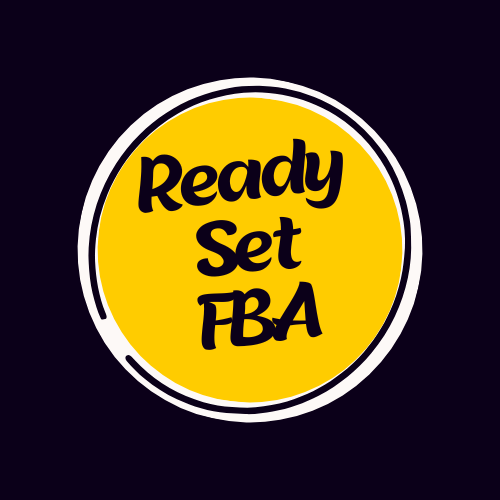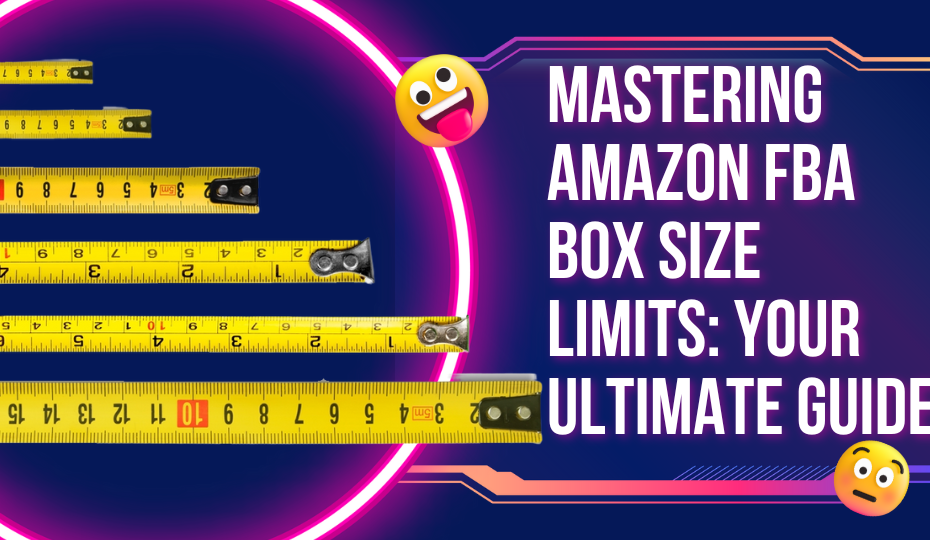· readysetfba · Fulfilment · 18 min read
Amazon FBA Size Tiers: A Guide to Product Sizes
Navigating the world of Amazon FBA can be a complex task, especially when it comes to understanding the nuances of product sizes. One of the critical aspects that every seller must grasp is the concept of Amazon FBA size tiers.
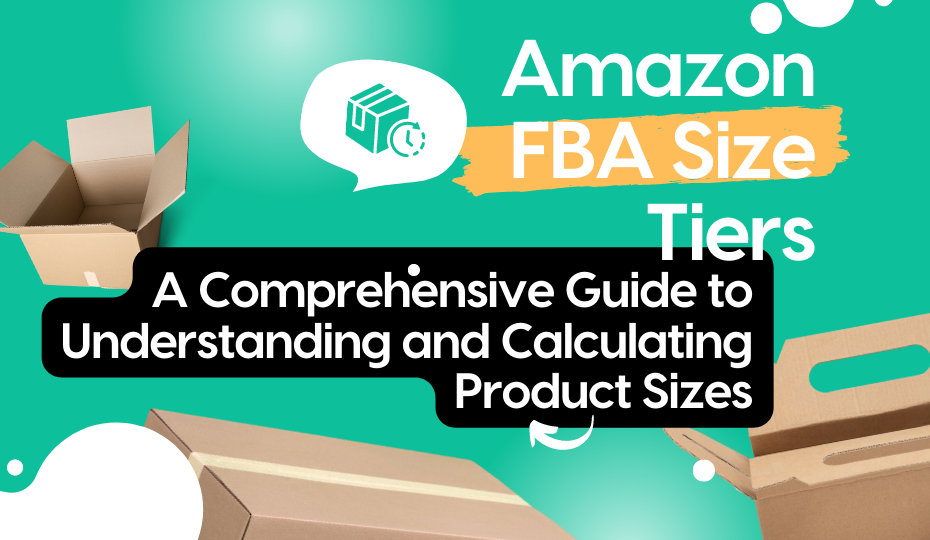
Navigating the world of Amazon FBA can be a complex task, especially when it comes to understanding the nuances of product sizes. One of the critical aspects that every seller must grasp is the concept of Amazon FBA size tiers. This guide aims to shed light on this crucial topic, providing you with a comprehensive understanding of Amazon FBA size tiers and how to calculate them for your products.
Amazon FBA, or Fulfillment by Amazon, is a service that allows sellers to store their products in Amazon’s fulfillment centers. Amazon then takes care of storage, packaging, and shipping of products, providing a streamlined process for sellers. However, the size of your product plays a significant role in this process, affecting storage fees, shipping costs, and even the success of your product on the platform. That’s where Amazon FBA size tiers come into play.
Understanding Amazon FBA size tiers is not just about knowing the dimensions of your product. It’s about comprehending how these dimensions translate into different size tiers, how these tiers affect your costs, and ultimately, your profitability. It’s about learning to navigate the system to make the most of your Amazon FBA experience.
In this guide, we will delve into the specifics of Amazon FBA size tiers, breaking down the complexities into understandable segments. We will explore the different size tiers, their specifications, and how to determine which tier your product falls into. We will also discuss the importance of product dimensions, unit weight, and dimensional weight, and how these factors influence your product’s size tier.
Whether you’re a seasoned Amazon seller or just starting, understanding Amazon FBA size tiers is crucial. It can help you make informed decisions about what products to sell, how to price them, and how to optimize your operations for maximum profitability. So, let’s embark on this journey of understanding Amazon FBA size tiers, and equip you with the knowledge to excel in your Amazon selling journey.
Also read About Us
Understanding Amazon FBA Size Tiers
Amazon FBA (Fulfillment by Amazon) is a service provided by Amazon that allows sellers to store their products in Amazon’s fulfillment centers. Amazon takes care of storage, packaging, and shipping of products, as well as customer service and returns. One of the critical aspects of this service is understanding Amazon FBA size tiers.
Amazon FBA size tiers are measurement categories that Amazon uses to calculate certain fees associated with using the FBA service. These tiers are based on the unit weight, product dimensions, and dimensional weight of a packaged item. Understanding these size tiers is crucial for sellers as it directly impacts the cost of using Amazon’s FBA service and, ultimately, the profitability of their business.
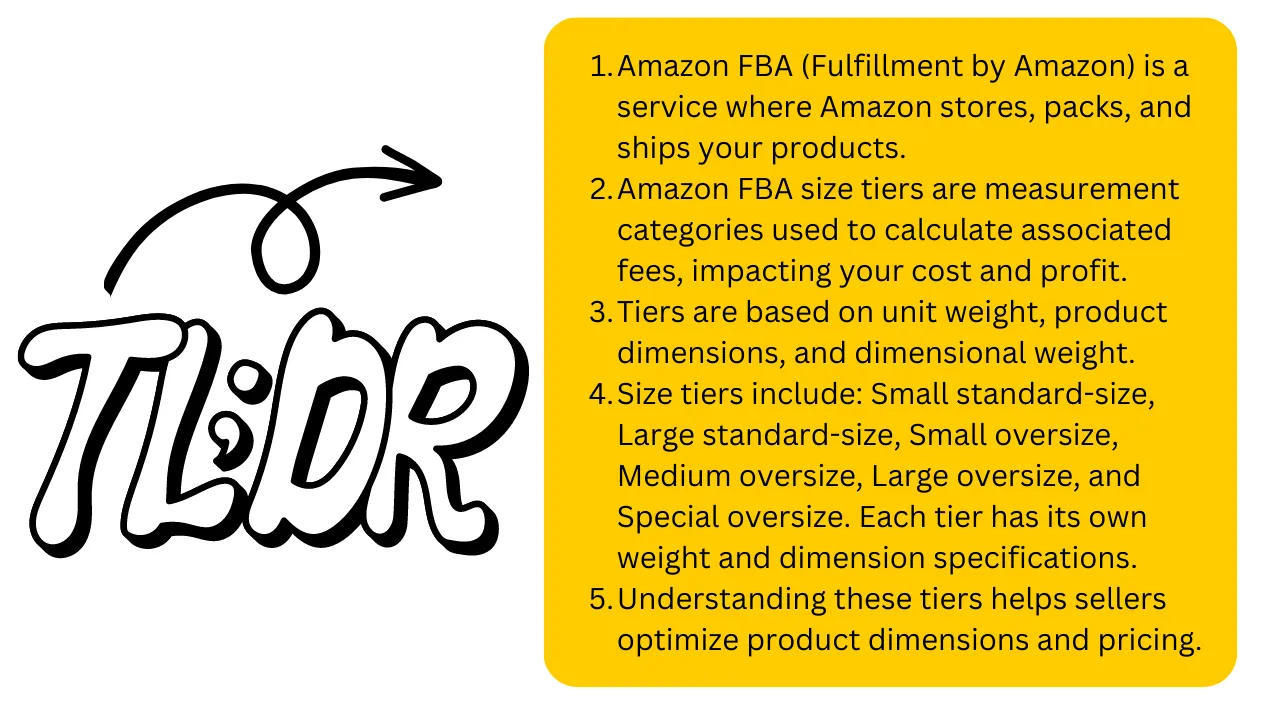
There are several different size tiers that Amazon uses, each with its own specifications.
These include:
- Small standard-size: This tier includes items weighing up to 16 oz, with the longest side measuring up to 15 inches, the median side up to 12 inches, and the shortest side up to 0.75 inch.
- Large standard-size: Items in this tier weigh up to 20 lb, with the longest side measuring up to 18 inches, the median side up to 14 inches, and the shortest side up to 8 inches.
- Small oversize: This tier includes items weighing up to 70 lb, with the longest side measuring up to 60 inches and the median side up to 30 inches. The length plus girth should not exceed 130 inches.
- Medium oversize: Items in this tier weigh up to 150 lb, with the longest side measuring up to 108 inches. The length plus girth should not exceed 130 inches.
- Large oversize: This tier includes items weighing up to 150 lb, with the longest side measuring up to 108 inches. The length plus girth should not exceed 165 inches.
- Special oversize: This tier includes any items that exceed the specifications of the large oversize tier.
Understanding these size tiers and their specifications is crucial for sellers using Amazon FBA. It allows them to accurately calculate the fees associated with using the service and to price their products appropriately. Furthermore, understanding the size tiers can help sellers optimize their product dimensions and packaging to fit into a lower-cost tier, potentially increasing their profitability.
In the next sections, we will delve deeper into key terms like unit weight, product dimensions, and dimensional weight, and how they are used to determine the size tier of a product. We will also provide a step-by-step guide on how to calculate these measurements for your products. So, stay tuned to become an expert in Amazon FBA size tiers.
Also read The Amazon Canonical Url Keyword Placement
In-depth Explanation of Key Terms
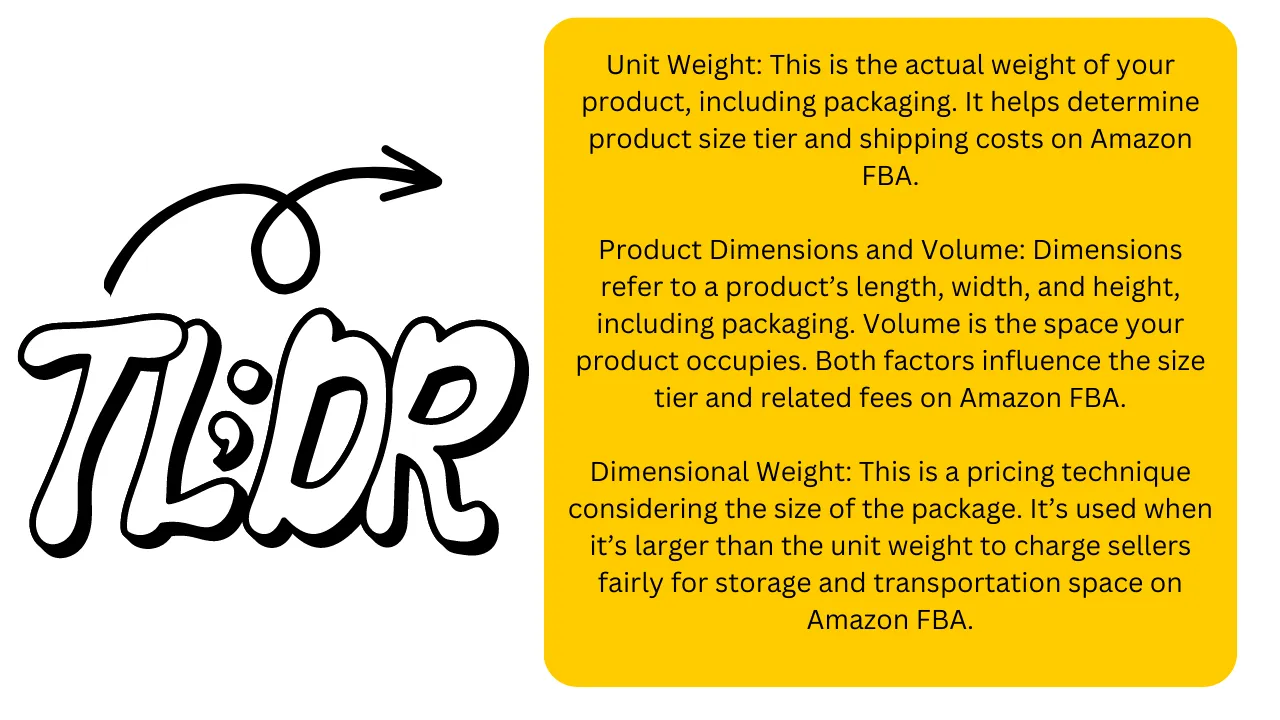
Understanding the language of Amazon FBA is crucial for sellers to navigate the platform effectively. In this section, we’ll delve into the key terms that are integral to the concept of Amazon FBA size tiers: “unit weight”, “product dimensions and volume”, and “dimensional weight”.
Unit Weight
The unit weight, often referred to as the actual weight, is the weight of the product itself, including the packaging. It’s measured in pounds (lbs) or ounces (oz) for the US marketplace. This is a fundamental factor in determining the size tier of your product on Amazon FBA.
Calculating the unit weight is straightforward. You simply need to weigh your product, including its packaging, using a reliable scale. Ensure that the scale is calibrated correctly to avoid any discrepancies.
The unit weight plays a significant role in determining the fees associated with Amazon FBA. The heavier the product, the higher the fulfillment fees, as it costs more to handle and ship heavier items.
Product Dimensions and Volume
Product dimensions refer to the length, width, and height of a product, including its packaging. The volume, on the other hand, is the amount of space that the product occupies, calculated by multiplying the length, width, and height.
To calculate the product dimensions, you need to measure the length, width, and height of the packaged product using a tape measure. The volume is then calculated by multiplying these three measurements.
The dimensions and volume of a product are crucial in determining its size tier on Amazon FBA. Larger products typically fall into the oversize tier and are subject to higher fulfillment fees due to the additional space they occupy in Amazon’s warehouses.
Dimensional Weight
Dimensional weight, also known as volumetric weight, is a pricing technique used by shipping companies, including Amazon, that takes into account the size of a package. It’s calculated by multiplying the length, width, and height of the package and then dividing by a specific divisor.
The formula for calculating dimensional weight is:
(Length x Width x Height) / Divisor
The divisor varies depending on the shipping carrier and the unit of measurement. For Amazon FBA, the divisor is typically 166 for measurements in inches and pounds.
Dimensional weight is used when it’s greater than the unit weight, as larger packages take up more space in a truck or warehouse, even if they’re lightweight. This ensures that sellers are charged fairly for the space their products occupy during storage and transportation.
Understanding these key terms and how they’re calculated is essential for Amazon FBA sellers. They not only help determine the size tier of your product but also the associated fees, impacting your overall profitability. By mastering these concepts, you can make informed decisions about your product selection and pricing strategy.
Also read Where Does Helium 10 Get Its Data
How to Determine Your Product Size Tier
Determining your product size tier is a crucial step in the Amazon FBA process. It not only helps you understand the fees associated with your product but also plays a significant role in inventory management and storage.
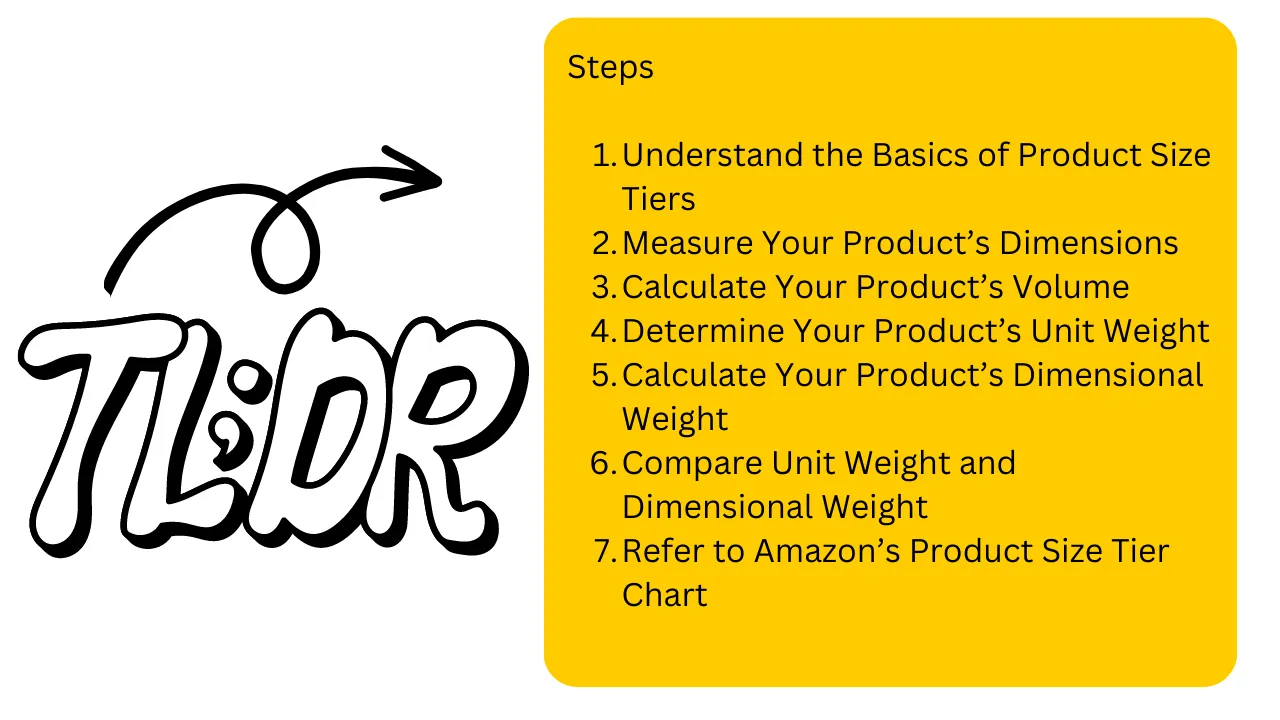
Here’s a step-by-step guide to help you navigate this process.
Step 1: Understand the Basics of Product Size Tiers
Before you start, it’s essential to understand what Amazon FBA size tiers are. Amazon categorizes products into different size tiers based on their dimensions, weight, and dimensional weight. These tiers include Small Standard-Size, Large Standard-Size, Small Oversize, Medium Oversize, Large Oversize, and Special Oversize. Each tier has specific weight and dimension requirements.
Step 2: Measure Your Product’s Dimensions
The next step is to measure your product’s dimensions. This includes the length, width, and height of the product when it’s fully packaged. Make sure to measure in inches as Amazon uses the imperial system for product dimensions.
Step 3: Calculate Your Product’s Volume
Once you have the product’s dimensions, you can calculate its volume. The formula for volume is length x width x height. This step is crucial as Amazon uses product volume to determine whether a product is standard-size or oversize.
Step 4: Determine Your Product’s Unit Weight
The unit weight of your product is its weight when it’s fully packaged, ready to be shipped. It’s important to note that Amazon uses the unit weight to calculate certain fees, so it’s essential to get this right.
Step 5: Calculate Your Product’s Dimensional Weight
Dimensional weight is a pricing technique used by shipping companies, including Amazon. It takes into account the package’s size in relation to its weight. To calculate the dimensional weight, multiply the length, width, and height (in inches), then divide by 166 for domestic shipments or 139 for international shipments.
Step 6: Compare Unit Weight and Dimensional Weight
Amazon uses the greater of the unit weight or dimensional weight to determine the product size tier. Compare the two weights and proceed with the larger one.
Step 7: Refer to Amazon’s Product Size Tier Chart
Now that you have all the necessary measurements and weights, refer to Amazon’s product size tier chart. Find the row in the chart that matches your product’s measurements and weight. This will be your product’s size tier.
Remember, accurately determining your product size tier is crucial for successful selling on Amazon. It not only affects your FBA fees but also impacts your inventory management and storage planning. So, take the time to understand and accurately calculate your product size tier. It’s a step you can’t afford to skip in your Amazon FBA journey.
| Steps | Description |
|---|---|
| 1 | Understand the Basics of Product Size Tiers |
| 2 | Measure Your Product’s Dimensions |
| 3 | Calculate Your Product’s Volume |
| 4 | Determine Your Product’s Unit Weight |
| 5 | Calculate Your Product’s Dimensional Weight |
| 6 | Compare Unit Weight and Dimensional Weight |
| 7 | Refer to Amazon’s Product Size Tier Chart |
Also read Common Terms Amazon
Real-life Examples of Product Size Tiers
When it comes to understanding Amazon FBA size tiers, real-world examples can be incredibly helpful. They provide a tangible reference point, making it easier to grasp the concept and apply it to your own products. Let’s explore some examples of different types of products and how their size tiers are determined.
Example 1: Books
Books are a common product sold on Amazon and they typically fall under the “Small standard-size” tier. For instance, a paperback novel with dimensions of 7.5 x 5.25 x 0.75 inches and a unit weight of 12 ounces would fit into this category. The longest side is less than 15 inches, the median side is less than 12 inches, and the shortest side is less than 0.75 inch, meeting all the criteria for this size tier.
Example 2: Kitchen Appliances
Consider a countertop blender, a popular kitchen appliance. With dimensions of 8 x 9 x 14 inches and a unit weight of 7 pounds, this product would fall under the “Large standard-size” tier. The longest side is less than 18 inches, the median side is less than 14 inches, and the shortest side is less than 8 inches, fitting the criteria for this size tier.
Example 3: Furniture
A piece of furniture, like a small coffee table, would typically fall under the “Small oversize” tier. Suppose the table has dimensions of 36 x 20 x 18 inches and a unit weight of 30 pounds. The longest side is less than 60 inches, and the median side is less than 30 inches, meeting the criteria for this size tier.
Example 4: Large Electronics
Large electronics, such as a 50-inch television, would fall under the “Large oversize” tier. With dimensions of 44 x 28 x 4 inches and a unit weight of 30 pounds, the longest side is less than 108 inches, fitting the criteria for this size tier.
Example 5: Fitness Equipment
Fitness equipment, like a standard barbell, would fall under the “Special oversize” tier. A barbell with dimensions of 86 x 3 x 3 inches and a unit weight of 45 pounds exceeds the limits of the “Large oversize” tier, placing it in the “Special oversize” category.
These examples illustrate how different products, from books to barbells, fit into Amazon’s FBA size tiers. Understanding these tiers is crucial for accurately calculating fees and maximizing your profits as an Amazon FBA seller. Remember, the size tier of a product is determined by its unit weight, product dimensions, and dimensional weight, so it’s essential to accurately measure and weigh your products.
| Product Type | Example | Dimensions (inches) | Unit Weight (pounds) | Size Tier |
|---|---|---|---|---|
| Books | Paperback Novel | 7.5 x 5.25 x 0.75 | 0.75 | Small standard-size |
| Kitchen Appliances | Countertop Blender | 8 x 9 x 14 | 7 | Large standard-size |
| Furniture | Small Coffee Table | 36 x 20 x 18 | 30 | Small oversize |
| Large Electronics | 50-inch Television | 44 x 28 x 4 | 30 | Large oversize |
| Fitness Equipment | Standard Barbell | 86 x 3 x 3 | 45 | Special oversize |
Also read Amazon Fba Calculator
Common Questions and Troubleshooting
Navigating the world of Amazon FBA size tiers can be complex, especially for new sellers. To help you understand and overcome common challenges, we’ve compiled a list of frequently asked questions and their answers, along with a troubleshooting guide for common issues.
Frequently Asked Questions
1. What are Amazon FBA size tiers?
Amazon FBA size tiers are categories based on the unit weight, product dimensions, and dimensional weight of a packaged item. These tiers are used to calculate certain fees, such as FBA fulfillment fees and monthly inventory storage fees.
2. How do I calculate the unit weight and dimensional weight of my product?
The unit weight is the weight of the product in its packaging ready for shipment. The dimensional weight is calculated by multiplying the length, width, and height of the package and then dividing by a specific divisor, which varies depending on the measurement system used.
3. What happens if my product dimensions exceed the specified size tier?
If your product dimensions exceed the specified size tier, it will be classified in the next size tier, which may result in higher fees.
4. How often should I check my product size tiers?
It’s recommended to check your product size tiers regularly, especially when adding new products or changing the packaging of existing products. This will ensure you’re always aware of the fees associated with your products.
Troubleshooting Guide
Issue: My product size tier seems incorrect. What should I do?
First, double-check your product dimensions and weight. Ensure you’re measuring the product in its packaging, as this is how Amazon will measure it. If you still believe there’s an error, you can request a Cubiscan from Amazon. This is a measurement of your product using Amazon’s equipment, which should provide an accurate size tier.
Issue: My fees are higher than expected. Could it be due to my product size tier?
Yes, your product size tier directly affects your FBA fees. If your product is larger or heavier than you initially thought, it could be in a higher size tier, resulting in higher fees. Review your product dimensions and weight, and ensure they’re accurate.
Issue: I’m struggling to calculate the dimensional weight of my product. Can you help?
Absolutely. The dimensional weight is calculated by multiplying the length, width, and height of the packaged product, then dividing by a specific divisor. The divisor varies depending on the measurement system used. If you’re still struggling, there are online calculators available that can help.
Remember, understanding Amazon FBA size tiers is crucial for managing your fees and maximizing your profits. If you encounter any issues, don’t hesitate to seek help or further information.
Also read Amazon Fba Pallet Requirements
Staying Updated with Amazon’s Policies on FBA Size Tiers
Navigating the Amazon FBA landscape requires a keen understanding of its policies, particularly those related to product size tiers. These policies are crucial as they directly influence your fulfillment fees and, ultimately, your profit margins.
However, Amazon’s policies and procedures are not static; they evolve over time, reflecting changes in market dynamics, customer preferences, and business strategies. Therefore, staying updated with these changes is not just beneficial—it’s essential for your success as an Amazon FBA seller.
Changes in Amazon’s FBA size tiers can occur due to various reasons, such as adjustments in shipping and handling processes, storage considerations, or changes in product trends.
These changes can affect how your products are categorized and the fees associated with them. Being unaware of these updates can lead to unexpected costs and impact your business planning.
So, how can you stay informed about changes in Amazon’s FBA size tiers? Here are a few strategies:
- Regularly Visit Amazon Seller Central: This is your primary source of information for all things related to selling on Amazon. Any changes in policies, including those related to FBA size tiers, are promptly updated here.
- Subscribe to Amazon’s FBA Newsletters: Amazon sends out regular newsletters to its FBA sellers, often including important updates about policy changes. Make sure you’re subscribed and read these updates diligently.
- Engage in Amazon Seller Forums: These forums are a treasure trove of firsthand experiences and insights from fellow sellers. They can be particularly helpful when trying to understand the practical implications of changes in FBA size tiers.
- Utilize Amazon’s Help Content: Amazon provides comprehensive help content, including detailed explanations of its FBA size tiers and related policies. This can be an invaluable resource for understanding any changes in depth.
- Attend Amazon’s FBA Webinars and Training Sessions: Amazon often conducts webinars and training sessions focused on FBA policies and best practices. These can provide valuable insights into any updates and how to adapt to them.
Remember, staying updated with Amazon’s FBA size tiers policies is a proactive strategy. It allows you to anticipate changes, adjust your operations accordingly, and maintain a competitive edge in the Amazon marketplace.
Also read What Countries Is Amazon In Global Footprint
Additional Resources
In the journey of mastering Amazon FBA size tiers, there are numerous resources available that can provide further insights and assistance. Here are some valuable tools and articles that can help you navigate the world of Amazon FBA more effectively.
- Amazon Seller Central: This is your go-to hub for all things related to selling on Amazon. It offers a wealth of information, guides, and tools to help you manage your Amazon FBA business. You can access it here.
- Amazon FBA Calculator: This is a handy tool that allows you to calculate potential profits for a product you’re considering selling on Amazon FBA. You can access it here.
- Amazon FBA Blogs and Forums: There are numerous blogs and forums where experienced sellers share their insights and experiences. Some recommended ones include The Helium 10 Blog, Fulfillment by Amazon subreddit, and Amazon Seller Forums.
- Amazon FBA Courses: If you’re looking for a structured learning experience, there are several online courses that provide comprehensive training on Amazon FBA. Some popular ones include Helium 10’s Freedom Ticket.
Remember, the key to success in Amazon FBA is continuous learning and staying updated with the latest trends and changes. These resources can provide you with the knowledge and tools you need to effectively manage your Amazon FBA business and succeed in the marketplace.
Also read Which Countries Are Allowed To Sell On Amazon Usa
Conclusion
In this comprehensive guide, we’ve delved deep into the world of Amazon FBA size tiers, providing you with a clear understanding of how to calculate and apply this crucial aspect of your Amazon selling journey.
We’ve explored the importance of understanding product dimensions, unit weight, and dimensional weight, and how these factors contribute to determining your product’s size tier.
The process of determining the size tier of your product is not just a regulatory requirement, but a strategic tool that can help you optimize your selling strategy on Amazon.
By accurately determining your product’s size tier, you can better predict your FBA fees, manage your inventory, and ultimately, maximize your profits.
We’ve also provided real-life examples to illustrate how these concepts apply to actual products, and answered some of the most frequently asked questions about Amazon FBA size tiers. We hope these examples and answers have clarified any doubts you might have had and provided you with practical insights.
Remember, staying updated with Amazon’s policies and procedures is crucial for your success as an Amazon seller. We’ve provided tips on how to stay informed about any changes, and we encourage you to regularly check for updates.
Finally, we’ve provided additional resources to further your understanding and help you navigate the Amazon FBA landscape. We encourage you to utilize these resources and continue learning.
In the world of Amazon FBA, knowledge is power. The more you understand about product sizes and how they impact your business, the better equipped you’ll be to succeed. So, apply this knowledge to your own products, and see the difference it makes.
Remember, every detail counts when it comes to selling on Amazon, and understanding your product’s size tier is a detail you can’t afford to overlook.
